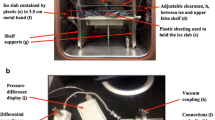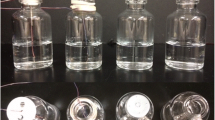Abstract
The vial design feature, such as the base curvature, acts as the primary heat transfer barrier in the lyophilization process. In this study, heat and mass transport characteristics of mannitol (5%) during vial freeze-drying are numerically investigated by including the vial base curvature effects. The influence of the product fill height, chamber pressure, and the vial base curvature on the product temperature, drying time, and mass transfer resistance is analyzed in detail. The diameter of the vial is taken as 15 mm, while the fill height of the product is varied from 3 to 5 mm. The chamber pressure is maintained between 5 and 50 Pa. The results revealed that the product with a 3 mm fill height experienced a 2.5 °C lower temperature than the product with a 5 mm fill height. As opposed to the flat vial predictions, if the vial base curvature effects are considered, the drying time is increased by 1.96 and 3.8 h for the 3 mm and 5 mm fill heights, respectively. The increased drying time is attributed to the reduced direct contact area between the vial and shelf and the vapor entrainment in the gap. The results showed that the dry layer mass transfer resistance contributes to 95% of the total mass transfer resistance; however, the contribution of semi-stoppered vial resistance is 1–2% only.












Similar content being viewed by others
Abbreviations
- A c :
-
Contact area between vial and shelf (m2)
- C p :
-
Heat capacity (J kg−1 K−1)
- C 1 :
-
Direct contact heat transfer model coefficient (W m−4 K−1)
- C 2 :
-
Gas heat transfer model coefficient (W m−2 K−1 Pa−1)
- F :
-
Visualization factor
- h :
-
Heat transfer coefficient (W m−2 K−1)
- I(t):
-
Sublimation interface position
- k :
-
Thermal conductivity (W m−1 K−1)
- k c :
-
Direct conduction heat transfer coefficient (W m−2 K−1)
- k g :
-
Gas conduction heat transfer coefficient (W m−2 K−1)
- k r :
-
Radiative heat transfer coefficient (W m−2 K−1)
- k v :
-
Total heat transfer coefficient (W m−2 K−1)
- l :
-
Effective curvature depth (mm)
- L :
-
Product height (mm)
- m :
-
Sublimation rate (kg s−1)
- N :
-
Mass flux (kg m−2 s−1)
- p c :
-
Chamber pressure (Pa)
- p eq :
-
Equilibrium vapor pressure of ice (Pa)
- p v :
-
Total pressure in the vial (Pa)
- q :
-
Heat flux (W m−2)
- R d :
-
Dry layer resistance (kPa s m2 kg−1)
- R s :
-
Semi-stoppered vial resistance (kPa s m2 kg−1)
- T :
-
Temperature (K)
- t :
-
Time (s)
- v n :
-
Normal velocity of sublimation interface (m s−1)
- z :
-
Spatial coordinate
- ΔH s :
-
Sublimation enthalpy of ice (J kg−1)
- ρ :
-
Density (kg m−3)
- σ :
-
Stefan Boltzmann constant (W m−2 K−4)
- α c :
-
Accommodation coefficient
- λ amb :
-
Heat conductivity of water vapor at ambient pressure (W m−1 K−1)
- Λ 0 :
-
Free molecular heat conductivity of water vapor at 0 °C (W Pa−1 K−1 m−2)
- f:
-
Sublimation interface/front
- s:
-
Shelf
- tp :
-
Top heating plate
- 1,d:
-
Dry layer
- 2,f:
-
Frozen layer
- wv:
-
Water vapor
References
Yamamoto Y, Hagura Y, Kawai K. Freeze-concentrated glass-like transition temperature of carbohydrate–phosphate buffered saline systems and impact on collapse of freeze-dried solids. J Therm Anal Calorim. 2020;142:1–9.
Talik P, Hubicka U. A study of the drying behaviour of various types of hydrated hydroxypropyl cellulose (HPC) and their mixtures with drugs of different solubility using DSC. J Therm Anal Calorim. 2019;143:1–8.
Alizadeh E, Chapleau N, de-Lamballerie M, Le-Bail A. Impact of freezing process on salt diffusivity of seafood: application to salmon (Salmo salar) using conventional and pressure shift freezing. Food Bioprocess Technol. 2009;2(3):257–62.
Srinivasan G, Raja B. Evaluation of immersion-contact type heat transfer for continuous pharmaceutical spin freeze-drying process. J Food Process Eng. 2020;43(1):e13153.
Rahman MS, Suresh S, Al-Habsi N. Proton relaxation in freeze-dried broccoli as measured by low-frequency nuclear magnetic resonance (LF-NMR) and its relationship with the thermal glass transition. J Therm Anal Calorim. 2020;1–13.
Talik P, Piwowarczyk J, Muszyńska B, Hubicka U. DSC study of hydration and water-holding behaviour of cultured in vitro mycelium and naturally grown fruiting bodies of freeze-dried Boletus badius, Agaricus bisporus and Cantharellus cibarius. J Therm Anal Calorim. 2020;1–8.
Mujumdar A. Handbook of industrial drying. New York: CRC Press; 2007.
Cohen JS, Yang TC. Progress in food dehydration. Trends Food Sci Technol. 1995;6(1):20–5.
Pikal MJ, Roy ML, Shah S. Mass and heat-transfer in vial freeze-drying of pharmaceuticals—role of the vial. J Pharm Sci-Us. 1984;73(9):1224–37.
Meng-Lund H, Holm TP, Poso A, Jorgensen L, Rantanen J, Grohganz H. Exploring the chemical space for freeze-drying excipients. Int J Pharm. 2019;566:254–63.
Arsiccio A, Giorsello P, Marenco L, Pisano R. Considerations on protein stability during freezing and its impact on the freeze-drying cycle: a design space approach. J Pharm Sci. 2020;109(1):464–75.
Fissore D, Gallo G, Ruggiero AE, Thompson TN. On the use of a micro freeze-dryer for the investigation of the primary drying stage of a freeze-drying process. Eur J Pharm Biopharm. 2019;141:121–9.
Assegehegn G, Brito-de la Fuente E, Franco JM, Gallegos C. Use of a temperature ramp approach (TRA) to design an optimum and robust freeze-drying process for pharmaceutical formulations. Int J Pharm. 2020;578:119116.
Assegehegn G, Brito-de la Fuente E, Franco JM, Gallegos C. An experimental-based approach to construct the process design space of a freeze-drying process: an effective tool to design an optimum and robust freeze-drying process for pharmaceuticals. J Pharm Sci. 2020;109(1):785–96.
King CJ. Freeze-drying of foods. London, UK: Butterworth & Co.(Publishers) Ltd.; 1971.
Sheehan P, Liapis AI. Modeling of the primary and secondary drying stages of the freeze drying of pharmaceutical products in vials: Numerical results obtained from the solution of a dynamic and spatially multi-dimensional lyophilization model for different operational policies. Biotechnol Bioeng. 1998;60(6):712–28.
Mascarenhas WJ, Akay HU, Pikal MJ. A computational model for finite element analysis of the freeze-drying process. Comput Method Appl M. 1997;148(1–2):105–24.
Hottot A, Peczalski R, Vessot S, Andrieu J. Freeze-drying of pharmaceutical proteins in vials: modeling of freezing and sublimation steps. Dry Technol. 2006;24(5):561–70.
Scutella B, Passot S, Bourles E, Fonseca F, Trelea IC. How vial geometry variability influences heat transfer and product temperature during freeze-drying. J Pharm Sci-Us. 2017;106(3):770–8.
Srinivasan G, Muneeshwaran M, Raja B. Numerical investigation of heat and mass transfer behavior of freeze drying of milk in vial. Heat Mass Transf. 2019;55(8):2073–81. https://doi.org/10.1007/s00231-018-02538-1.
Song CS, Nam JH, Kim CJ, Ro ST. Temperature distribution in a vial during freeze-drying of skim milk. J Food Eng. 2005;67(4):467–75.
Kumar KN, Mallik S, Sarkar K. Role of freeze-drying in the presence of mannitol on the echogenicity of echogenic liposomes. J Acoust Soc Am. 2017;142(6):3670–6.
Fritsching U. Process-spray: functional particles produced in spray processes. Springer; 2016.
Hua T-C, Liu B-L, Zhang H. Freeze-drying of pharmaceutical and food products. Elsevier; 2010.
Cannon A, Shemeley K. Statistical evaluation of vial design features that influence sublimation rates during primary drying. Pharm Res-Dordr. 2004;21(3):536–42.
Kramer T, Kremer DM, Pikal MJ, Petre WI, Shalaev EY, Gatlin LA. A procedure to optimize scale-up for the primary drying phase of lyophilization. J Pharm Sci-Us. 2009;98(1):307–18.
Nail SL. The effect of chamber pressure on heat transfer in the freeze drying of parenteral solutions. PDA J Pharm Sci Technol. 1980;34(5):358–68.
Velardi SA, Rasetto V, Barresi AA. Dynamic parameters estimation method: advanced manometric temperature measurement approach for freeze-drying monitoring of pharmaceutical solutions. Ind Eng Chem Res. 2008;47(21):8445–57.
Pisano R, Fissore D, Barresi AA. Freeze-drying cycle optimization using model predictive control techniques. Ind Eng Chem Res. 2011;50(12):7363–79.
Khalloufi S, Robert JL, Ratti C. Solid foods freeze-drying simulation and experimental data. J Food Process Eng. 2005;28(2):107–32.
Chakraborty R, Saha A, Bhattacharya P. Modeling and simulation of parametric sensitivity in primary freeze-drying of foodstuffs. Sep Purif Technol. 2006;49(3):258–63.
Liapis AI, Marchello J. Advances in the modeling and control of freeze-drying. 1984.
Warning AD, Arquiza JMR, Datta AK. A multiphase porous medium transport model with distributed sublimation front to simulate vacuum freeze drying. Food Bioprod Process. 2015;94:637–48.
Pikal MJ. Heat and mass transfer in low pressure gases: applications to freeze drying. Drugs Pharm Sci. 2000;102:611–86.
Kuu WY, Nail SL, Sacha G. Rapid determination of vial heat transfer parameters using tunable diode laser absorption spectroscopy (TDLAS) in response to step-changes in pressure set-point during freeze-drying. J Pharm Sci-Us. 2009;98(3):1136–54.
Zadravec M, Ramsak M, Ravnik J, Iljaz J, Avanzo M, Kocevar K et al. Numerical and experimental modeling of lyophilization of lactose and mannitol water solitions in vials
Bogdani E, Vessot S, Andrieu J. Experimental and modeling study during freeze drying of aqueous tert-butanol-based formulations in vials. Dry Technol. 2013;31(15):1772–9.
Acknowledgements
The authors would like to thank the Department of Science and Technology (DST-SERC), India (Ref no: SR/S3/MMER/0005/2014) and Ministry of Science and Technology, Taiwan (Contract Nos: 108-2622-E-009-004-CC2 and 108-2622-E-009-027-CC2) for their financial aid to carry out the work.
Author information
Authors and Affiliations
Corresponding author
Additional information
Publisher's Note
Springer Nature remains neutral with regard to jurisdictional claims in published maps and institutional affiliations.
Rights and permissions
About this article
Cite this article
Muneeshwaran, M., Srinivasan, G., Raja, B. et al. Investigation of heat and mass transfer behavior of mannitol during vial freeze-drying. J Therm Anal Calorim 147, 2393–2404 (2022). https://doi.org/10.1007/s10973-021-10635-3
Received:
Accepted:
Published:
Issue Date:
DOI: https://doi.org/10.1007/s10973-021-10635-3




